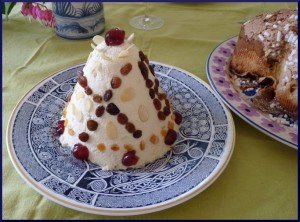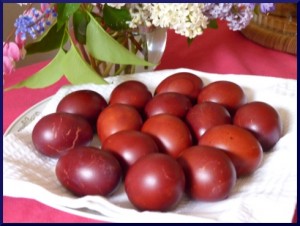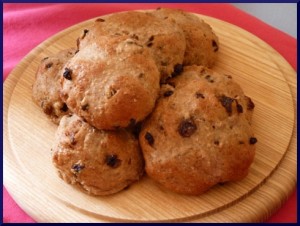Although I don’t claim to be particularly religious, I do like the surviving private (as in ‘within the home’) rituals associated with food. The day before Lent, Shrove Tuesday, for example, is the day when we blend together milk, eggs, and flour into pancakes (which we then eat with savoury and sweet fillings). So, the end of Lent, Easter, is marked with dishes that bring back (in rather large quantities) those foods we were not supposed to be eating during Lent. Pascha is one such dish, comprising cheese, eggs, cream, butter, sugar and decorated with dried fruits and nuts. Traditionally it is eaten with its own bread, kulich, but we usually just serve it with a similar Italian Easter bread (Colomba Pasquale, which I don’t make myself). Whilst I don’t own a traditional pascha ‘mould’ (I use a stainless steel conical colander that has lost its handle), I do retain something of the religious signage in the decoration.
Make this on Easter Saturday (i.e. the day before Easter). Use organic ingredients where you can.
500g tvorog cheese (sorry, I don’t have a recommended substitute — visit your local Russian delicatessen)
2 egg yolks
1 egg white
50g unsalted butter
100g caster sugar
150ml double cream (whipped)
1 tbsp mixed peel
1.5 tbsp almond flakes
1 cheesecloth
1 conical mould that allows for drainage (I use a colander; others seem to use well-scrubbed flower pots…)
Raisins/sultanas, mixed peel, glacé cherries, blanched almonds for decoration
Whisk egg white until soft peaks are formed. Whisk egg yolks with half the sugar until light in colour. Beat butter with remaining sugar until fluffy. Combine egg-sugar mix with butter-sugar mix. Beat in tvorog. Fold in whipped cream. Fold in egg white. Fold in mixed peel and almond flakes.
Line the mould with the cheesecloth. Spoon the pascha mixture into the mould. Fold over the cheesecloth to protect the top of the pascha. Place the mould into a suitable dish to allow for drainage. Place saucer or other suitable disc on the top and then add a weight (I use a small but heavy marble mortar). Place in refrigerator and allow to drain overnight.
On Easter Sunday morning remove the weight; the jug with any water; and unwrap the cheesecloth from the top of the mould. Place a decorated plate over the top and carefully flip the mould and place upright. When you remove the remainder of the cheesecloth you should have a white, firm conical-shaped pascha which you can now decorate. It is traditional for the pascha to be marked with the cyrillic letters X and B (abbreviation for Христосъ Воскресe, “Christ is risen!”). Since I don’t have a traditional pascha mould, I do this with raisins or sultanas (this year, soaked in rum). The rest of the pascha is lightly decorated with peel, glacé cherries, and blanched almonds in the Byzantine fashion.


